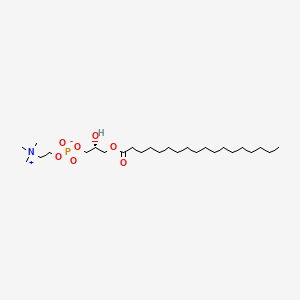| MeSH term | MeSH ID | Detail |
|---|---|---|
| Diabetes Mellitus, Type 2 | D003924 | 87 associated lipids |
| Diabetes Mellitus, Experimental | D003921 | 85 associated lipids |
| Arteriosclerosis | D001161 | 86 associated lipids |
| Hyperlipidemias | D006949 | 73 associated lipids |
1-octadecanoyl-sn-glycero-3-phosphocholine
1-octadecanoyl-sn-glycero-3-phosphocholine is a lipid of Glycerophospholipids (GP) class. 1-octadecanoyl-sn-glycero-3-phosphocholine is associated with abnormalities such as Septicemia. The involved functions are known as Phosphorylation, MAP kinase activity, Phagocytosis, protein serine/threonine kinase activity and Uptake. The associated genes with 1-octadecanoyl-sn-glycero-3-phosphocholine are FPR1 gene and OLR1 gene. The related lipids are Lysophosphatidylcholines.
Cross Reference
Introduction
To understand associated biological information of 1-octadecanoyl-sn-glycero-3-phosphocholine, we collected biological information of abnormalities, associated pathways, cellular/molecular locations, biological functions, related genes/proteins, lipids and common seen animal/experimental models with organized paragraphs from literatures.
What diseases are associated with 1-octadecanoyl-sn-glycero-3-phosphocholine?
1-octadecanoyl-sn-glycero-3-phosphocholine is suspected in Septicemia and other diseases in descending order of the highest number of associated sentences.
Related references are mostly published in these journals:
| Disease | Cross reference | Weighted score | Related literature |
|---|
Possible diseases from mapped MeSH terms on references
We collected disease MeSH terms mapped to the references associated with 1-octadecanoyl-sn-glycero-3-phosphocholine
PubChem Associated disorders and diseases
What pathways are associated with 1-octadecanoyl-sn-glycero-3-phosphocholine
There are no associated biomedical information in the current reference collection.
PubChem Biomolecular Interactions and Pathways
Link to PubChem Biomolecular Interactions and PathwaysWhat cellular locations are associated with 1-octadecanoyl-sn-glycero-3-phosphocholine?
There are no associated biomedical information in the current reference collection.
What functions are associated with 1-octadecanoyl-sn-glycero-3-phosphocholine?
Related references are published most in these journals:
| Function | Cross reference | Weighted score | Related literatures |
|---|
What lipids are associated with 1-octadecanoyl-sn-glycero-3-phosphocholine?
Related references are published most in these journals:
| Lipid concept | Cross reference | Weighted score | Related literatures |
|---|
What genes are associated with 1-octadecanoyl-sn-glycero-3-phosphocholine?
Related references are published most in these journals:
| Gene | Cross reference | Weighted score | Related literatures |
|---|
What common seen animal models are associated with 1-octadecanoyl-sn-glycero-3-phosphocholine?
There are no associated biomedical information in the current reference collection.
NCBI Entrez Crosslinks
All references with 1-octadecanoyl-sn-glycero-3-phosphocholine
Download all related citations| Authors | Title | Published | Journal | PubMed Link |
|---|---|---|---|---|
| pmid: | ||||
| Tang D et al. | Quercetin prevents LPS-induced high-mobility group box 1 release and proinflammatory function. | 2009 | Am. J. Respir. Cell Mol. Biol. | pmid:19265175 |
| Vesterqvist O et al. | Quantitation of lysophosphatidylcholine molecular species in rat cardiac tissue. | 1992 | Anal. Biochem. | pmid:1514697 |
| Soga T et al. | Lysophosphatidylcholine enhances glucose-dependent insulin secretion via an orphan G-protein-coupled receptor. | 2005 | Biochem. Biophys. Res. Commun. | pmid:15607732 |
| Hui SW and Huang CH | X-ray diffraction evidence for fully interdigitated bilayers of 1-stearoyllysophosphatidylcholine. | 1986 | Biochemistry | pmid:3964679 |
| Wu W et al. | Lamellar--micellar transition of 1-stearoyllysophosphatidylcholine assemblies in excess water. | 1982 | Biochemistry | pmid:7150539 |
| Mansfield PJ et al. | Regulation of polymorphonuclear leukocyte degranulation and oxidant production by ceramide through inhibition of phospholipase D. | 2002 | Blood | pmid:11830497 |
| Berdel WE et al. | Early tumor and leukemia response to alkyllysophospholipids in a phase I study. | 1982 | Cancer | pmid:7127246 |
| King MT et al. | Failure to detect mutagenic effects of anti-tumor alkyl-lysophospholipids. | 1981 | Cancer Lett. | pmid:6790162 |
| Berdel WE et al. | Alkyl-lysophospholipids lack influence on the occurrence of radiation-induced lymphomas and AKR-leukemia. | 1983 | Cancer Lett. | pmid:6686802 |
